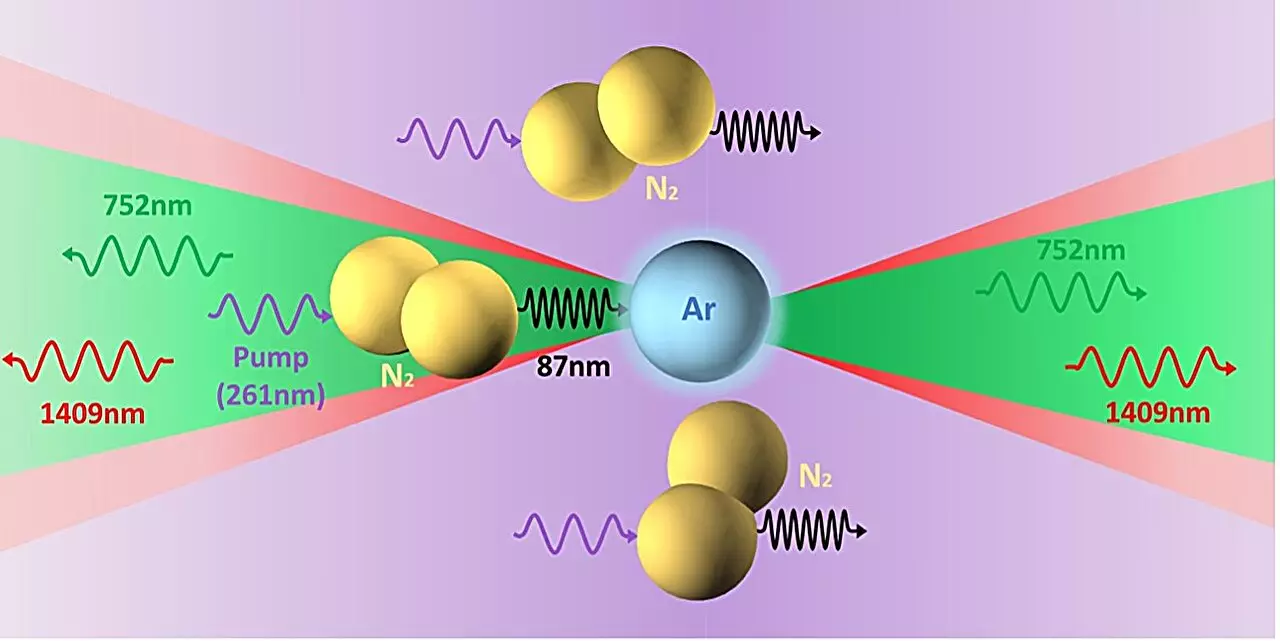Lasers are an enduring cornerstone of modern technology, characterized by their ability to produce coherent light through a carefully orchestrated interplay of mirrors and optical cavities. Traditionally, this process involves bouncing light within these cavities to amplify the intensity until it breaks free as a concentrated beam. However, a groundbreaking exploration has emerged, demonstrating that similar phenomena can occur outside traditional constraints—specifically within the Earth’s atmosphere, leading to a new understanding of what constitutes lasing.
Researchers from the University of California, Los Angeles (UCLA), along with their counterparts at the Max Born Institute, recently published a pivotal paper in *Physical Review Letters* that sheds light on this revolutionary new form of lasing. The research focuses on a previously unrecognized mechanism whereby photons facilitate energy transfer from nitrogen (N2) to argon (Ar), enabling lasing in open air—a feat long considered a theoretical puzzle within the field.
Co-author Chan Joshi highlighted an intriguing observation: the ionization rate of argon under high field conditions displayed unexpected behavior when subjected to a 261 nm pump laser. The empirical measurements diverged from predictions made by existing theories, prompting further investigation into the potential role of three-photon resonant absorption processes. This endeavor led to unprecedented discoveries in light emission dynamics.
The research team’s diligent experiments uncovered that when argon atoms absorbed three photons of 261 nm light, it resulted in a cascade of superfluorescent emissions. This mechanism operates devoid of an optical cavity, marking a significant departure from conventional laser operations. Lead author Zan Nie remarked on an astonishing discovery during their experiments: the ability of this cascaded superfluorescence to change wavelengths when mixed with just 1% argon in the air.
Further analysis revealed that the coupling between nitrogen and argon is the linchpin of this newfound lasing mechanism. The experiment’s outcomes indicated that nitrogen’s interaction with argon mirrors the behavior observed when using ambient air, while mixtures involving other gases like oxygen or helium did not yield similar results. This finding directed focus to the specific interactions between nitrogen and argon as the core facilitators of air lasing phenomena.
The implications of this research extend beyond mere curiosity; they represent a significant leap towards practical applications in technology and science. Co-author Misha Ivanov noted that the ultimate goal of producing a laser in the air capable of generating a return beam of laser-like light could revolutionize remote sensing applications. This bidirectional laser action highlights a significant advancement, as it paves the way for devices that could harness atmospheric phenomena for various uses, including environmental monitoring and communication technologies.
The newfound mechanism also reveals that electronically excited nitrogen molecules engage in nonlinear three-photon absorption at slightly different frequencies than argon. This differential frequency is crucial, as it establishes the upper excited state essential for observing the cascaded superfluorescent emissions, providing insight into previously uncharted physical interactions.
Looking ahead, the research team is poised to delve deeper into the intricacies of this atmospheric lasing mechanism. One area of focus will be on quantum beating—a phenomenon that arises from simultaneous excitation of multiple energy levels in argon. The oscillations of charge density resulting from this excitation could yield valuable insights into the existence of novel energy levels in argon and elucidate the vibrational-rotational states of nitrogen that contribute to the coupling process.
As researchers continue to explore this cutting-edge territory, the potential applications of cavity-free lasing in atmospheric conditions grow increasingly promising. This innovative avenue of study could not only enhance our understanding of light and matter interactions but also lead to the development of next-generation sensors and communication systems that leverage the unique properties of air to facilitate new discoveries.
The exploration of cavity-free lasing represents a significant departure from traditional laser physics, unveiling mechanisms that enable light manipulation in novel environments. The collaborative efforts of the UCLA and Max Born Institute teams have illuminated pathways toward understanding complex photon-mediated processes, offering a glimpse into a future where atmospheric conditions can be harnessed effectively. As science ventures further into uncharted realms like this, the potential for transformative technological advancements becomes ever more tangible, forever altering our perspective on light and its role in our universe.

